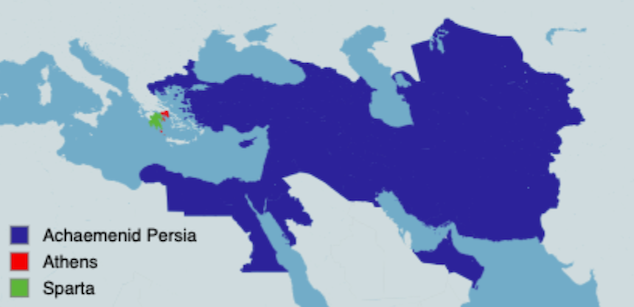Texts in Context:
The Beginning of the Græco-Persian War

By Gabriel Blanchard
Now we enter upon the "storied" parts of ancient history. A word seems in order, then, about stories; and so do a couple of stories.
What Is “Classical” History?
Here, we have at last come upon the part of ancient Greek history generally regarded as “classical.” Unfortunately, “classical” is one of those words that not only has many definitions, but tends to get tossed around without any clarity about which one is meant. Let’s digress for a bit to understand what it means.
“Classical” ultimately comes from the Latin noun classis, meaning “class” or “group.” Now, in many languages, words that indicate qualities, especially rank-able qualities, tend to assume an implication that they are good examples of their meanings (think of how calling products “quality merchandise” is a boast or a compliment, even though badness is a quality just as much as goodness). In this way, classis came to mean especially the highest class of Roman society, the patricians, from whom members of the Senate were drawn.* This highest class, having the leisure to devote to such things, both produced and studied much of the literature we now call “classical,” as well as bestowing patronage on artists of humbler origins that allowed them to devote their time to their art. In this sense, classical is simply a fancier-sounding synonym for classy.
But this “classical education” (already known in ancient times as “liberal education,” i.e. the education befitting a līberālis or free man) has a history of its own; and once something is given a name that sticks, that thing’s history often colors the meaning of the name. The vicissitudes** of the Renaissance are particularly important here. Medieval education had, of course, stayed strong in the field of Latin. However, during the Late Middle Ages (roughly the fourteenth and fifteenth centuries), some scholars felt the curriculum had become stifling, due both to restrictions on what could be studied and to the accumulation of new material from Scholastic divines and philosophers. These Renaissance humanists advocated a return to the original sources—their famous slogan was ad fontes, “to the springs”—that classical education had started with: the great pre-Christian and early Christian works of philosophy, science, and literature with which the ancients had taught their children, and which the monks of the so-called Dark Ages had diligently copied and preserved from destruction. Thus, besides meaning “first-rate,” “masterly work,” or “excellent,” classic and classical came also to mean something like “that which serves as a standard or reference point for other work of the same kind.” The classical period of a civilization is that period which, especially in retrospect, defines it.
γλυκύ δ᾽ἀπείρῳ πόλεμος.
πεπειραμένων δέ τις ταρβεῖ προσιόντα νιν καρδία περισσῶς.
Yea, sugar-sweet is war—to the untried:
Who knows it, his heart shakes as it draws nigh.Pindar of Thebes, frag. 110
Thus, when we speak of “Classical Greece” or “Classical Rome,” it’s typical to have two quite specific time periods in mind.† A period of a little under two and a half centuries—from 47 BC (the effective beginning of Julius Cæsar’s all-but-in-name reign as emperor) to 192 AD (the death of Marcus Aurelius’ son and successor, Commodus)—is more or less the maximum range of what we mean by “Classical Rome.” The maximum for “Classical Greece” is normally held to end with the death of Alexander the Great in 323 BC, after which his empire split up; its beginning can be conveniently pegged to a date about one and a half centuries earlier: the year 492 BC, when the Persian emperor launched his invasion of Greece, and a handful of the Greeks fought back. And with this, we turn from our digression back to the actual history of Classical Greece.
The Second Campaign Against the Hellenes
We have already discussed the first campaign against the Hellenes: this was the six-year pacification of Ionia, 499-493 BC. The very next year, Darius had already authorized further military action in the area. Some of the northerly regions of Greece were promptly subjugated; in 491, having made his intentions and the ridiculous scale of his power clear, Darius sent envoys around the city-states of the Greeks, with a familiar salutation: “Earth and water.” Supposedly, just two cities refused—as it happened, the two strange extremes of Greek society. The Athenians threw the Persian ambassador down a gorge, reportedly with the mocking remark that he could get the earth himself if he wanted it; the Spartans, as in the famous film, flung the man who came to them down a well. For an inkling of how insane this was, please refer to the map below.

Thus we come, in the year 490, to the Battle of Marathon. The Battle of Thermopylæ, fought ten years later, is the more famous of the two, and justly so; but there is a reason the name of Marathon‡ has passed into our language. The Persian military had just swept over the populous and powerful islands of Naxos and Euboea; Athens was next. A messenger was dispatched to run to Sparta and beg for help, but it was over a hundred and fifty miles (equivalent to running from New York to Baltimore)—only to find the pious Spartans in the midst of a festival, unable to come to the aid of their Attic neighbors for over a week. Only the little city of Platæa (west of Attica, toward Delphi) was able to bolster Athens’ nine or ten thousand hoplites with another thousand, earning their lasting gratitude. The Persians made landfall, on the other hand, with forces that outnumbered the Hellenes two to one even by the most conservative modern estimates; a Roman historian from the first century BC has the Greeks outnumbered ten to one. Whatever the numbers, under the direction of General Miltiades (who had faced the Persians in battle before), the Athenians and Platæans attacked … and won.
How exactly this gave its name to the marathon of the modern Olympics is rather confused; several conflicting accounts are given, but the one that seems the clearest goes like this. As the Persians were departing by sea after their defeat, one of the Hellene soldiers, a man named Eucles,§ spotted a ship changing course from the main body of the fleet, turning south—toward Athens. Realizing that this could be a last-ditch effort to bring false news of a Persian victory and cow the Athenians that way, Eucles discarded weapons, armor, even clothing to make himself lighter, and bolted from the field of Marathon all the way to the city, beating the ship in question and bursting into the assembly to cry, “We won!” With that, he collapsed and died of exhaustion, having just sprinted a distance of about twenty-six miles.
*This class was, legally, determined by both heredity and wealth. Only Roman citizens from patrician families were eligible, these families being supposedly the descendants of the first hundred men chosen as senators by Romulus, the founder and first King of Rome. But even among patricians, any who had not maintained a high enough degree of wealth were (in theory) ineligible to be senators.
**Vicissitude, noun. Change or alteration, especially of a regular or recurring type. From the Lat. vīcissim, “on the other hand.”
†It may be worthwhile to reread our early post in this series discussing periodization; historical periods vary from one scholar or school of thought to another. Note, too, that referring to a period as “classical” sometimes refers specifically to the style of language in use at the time. In this sense, both Classical Greek and Classical Latin (or “Golden Age” Latin) tend to mean shorter periods: the late fifth to late fourth centuries BC for the former, and the first century BC for the latter.
‡In Greek, μάραθον [marathon] was the name of the fennel plant, which grew plentifully on the northeastern coast of Attica, where the battle was fought.
§If you were expecting the name Pheidippides here, that’s actually supposed to have been the name of the messenger sent to Sparta.
Gabriel Blanchard is the editor at large for CLT. He lives in Baltimore, MD.
If you enjoyed this piece, you might also take an interest in our introduction to one of the principal sources for the Græco-Persian War, Herodotus—or some of the other men and women of the CLT Author Bank, like St. Athanasius, Moses Maimonides, Mary Wollstonecraft, Fyodor Dostoevsky, and John Steinbeck.
Published on 17th June, 2024. Page image of a kylix (a type of drinking bowl) depicting a a Greek hoplite on the right and a Persian soldier on the left: note the breeches (not then used in Europe) and elongated cap worn by the Persian.